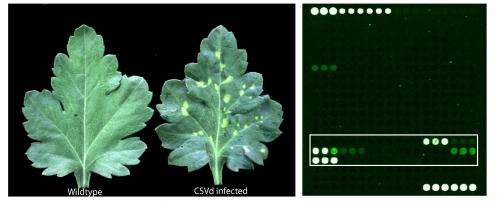Universal microarray platform for screening plant pathogen infection

A large number of plant pathogens, ranging from small infectious particle viroids to pathogenic plants, can cause diseases in crops. The infected plants may develop mild symptoms or devastating disease. The estimated loss due to plant diseases is about $60 billion annually. However, plant pathogens are difficult to detect and control due to a wide variety of pathogens. Furthermore, globalization and the increase in international trade bring further threats of introducing foreign pathogens to local crops.
Screening for plant pathogenic infections is difficult and time consuming. Until now, there has been no fast and simple test to identify all pathogens. However, the development of a new microarray approach has led to the most comprehensive strategy to date. A universal microarray technology has been developed to detect hundreds of different viroid and virus infections in the plant. This study was recently published in PLOS ONE by an international collaborated project between Dr. Jun Yin, from University College Dublin, Ireland, and a group of plant virology experts from Chinese Academy of Inspection and Quarantine and Chinese Academy of Agricultural Sciences, including Dr. Shuifang Zhu, Dr. Yongjiang Zhang and Dr. Shifang Li.
"This study will lead to a cheaper and more effective way of detecting plant pathogens. This novel microarray platform is able to screen hundreds of viroid or virus infections in a single test," said Dr. Yin. "We are using an advanced algorithm to reduce the number of DNA probes used on the microarray, thus the cost of the microarray is greatly reduced."
The microarray is a glass slide spotted with thousands of probes. Each probe is a piece of DNA sequence similar to the virus or viroid sequences. The complementary binding of probes to the virus or viroid sequences will emit fluorescent signals detectable by a scanner. In their recent publication in PLOS ONE, the researchers released a microarray with only about 100 probes, but were able to detect all of the eight known viroid genera including 37 viroid species. An earlier microarray developed by the team published in the Journal of Virological Methods used about 350 probes to detect more than 160 plant viruses. Together, the probes designed and validated in these two studies enable detection of hundreds of viroid and virus species in a single test.
"An exciting application of the microarray is to detect emerging pathogenic infections of plants," said Dr. Shuifang Zhu, project co-investigator and expert of plant disease diagnosis and control. "These emerging diseases may come from local pathogens changing habitats or pathogens brought by international trade. The microarray platform provides an accurate and affordable means of screening and detecting plant virus or viroid infections. This will greatly benefit the farmers, gardeners, and even investigators in the government to quickly identify and quarantine the diseased plants."
More information: Zhang Y#, Yin J#, Jiang D, Xin Y, Ding F, et al. (2013) A universal oligonucleotide microarray with a minimal number of probes for the detection and identification of viroids at the genus level. PLOS ONE. dx.plos.org/10.1371/journal.pone.0064474
Zhang Y#, Yin J#, Li G, Li M, Huang X, et al. (2010) Oligonucleotide microarray with a minimal number of probes for the detection and identification of thirteen genera of plant viruses. J Virol Methods 167: 53-60. www.sciencedirect.com/science/ … ii/S016609341000090X
#Authors contributed equally
Journal information: PLoS ONE
Provided by Yale University

















